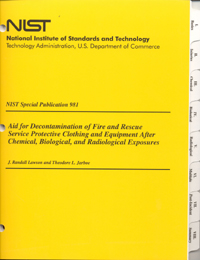Page 2

The report, NIST SP 981, Aid for Decontamination of Fire and Rescue Service Protective Clothing and Equipment After Chemical, Biological, and Radiological Exposures, provides first responders with basic emergency decontamination aid of personal protective clothing and equipment (PPE) in the event that it is exposed to CBR contamination. The report provides some basic guidelines for handling equipment exposed to relatively lower concentration CBR environments where human rescue is practical. NFPA 1971, Standard on Protective Ensembles for Structural
Fire Fighting and other NFPA (National Fire Protection Association) standards are discussed. It is recommended that all relevant NFPA standards be kept with the NIST report. Guidelines for storing protective clothing and equipment safely after a CBR exposure also are included. For anyone in cold geographic regions or areas that have temperature extremes, another report may be of interest: Guidelines for Cold Weather Mass Decontamination During a Terrorist Chemical Agent Incident (published by SBCCOM…
the US Army Soldier and Biological Chemical Command). It has information on cold weather contamination. The report was published on 12 April 2002 and to download it from their web site, go to: http://www.sbccom.army.mil/ ; next, click on SBCCOM ONLINE and search the report title.
For additional information, contact Randy Lawson, telephone: (1) + 301-975-6877; e-mail: james.lawson@nist.gov.
Scientists and engineers in the Fire Research Division of the National Institute of Standards and Technology (NIST) are developing mathematical/computational fire models to predict the spread of fires through both wildland fuels and structures. Such landscapes, where wildland fuels (trees, shrubs and grasses) and houses and/or other manmade structures coexist are known as the urban-wildland interface (UWI). As people have built in more remote areas, UWI fires have become much more common, dangerous and expensive.

Record of a generic property in the demonstration community of South Lake Tahoe. In its final form, users will manipulate building materials and vegetation to study the effect on fire resistance.
Simulation based on a predicted grass fire spread.
Click on picture to download the 3MB animation.
The problem of UWI fires has become a more prominent issue, both in the United States and elsewhere. NIST researcher Ron Rehm has teamed up with colleague Lisa de Jong at the Pacific Southwest Research Station (PSW) of the Forest Service to address this pressing problem. The Center for Urban Forest Research of the PSW, located in Davis, CA, has as its mission, the study of natural vegetation in an urban or suburban setting. One project, which falls under the interagency National Fire Plan, is a comparison of alternates to “firewise” landscapes. It evaluates vegetation characteristics that homeowners value, such as beauty, shade, privacy and wildlife habitat, relative to the increased susceptibility of their residences to wildfire from the vegetation.
In this project, NIST fire scientists and engineers are developing a simple module describing fire spread to be incorporated into the more comprehensive model for alternate firewise landscapes. In final form, this model will allow homeowners to determine how vulnerable their house is to a wildfire that has entered their community. Next, it allows them to determine how changes in the vegetation on their property could reduce their risks.
The video simulation accompanying this article shows the calculated progression of a grass fire, arising from a wildfire that has invaded the community, over a homeowner’s property. More refined simulations will allow the homeowner to assess the value of changes in landscape vegetation on the vulnerability of their house to fire.
For additional information, contact: Ron Rehm, (1) + 301-975-2704, ronald.rehm@nist.gov. OR Lisa de Jong (1) +530-754-8908, ldejong@ucdavis.edu.
